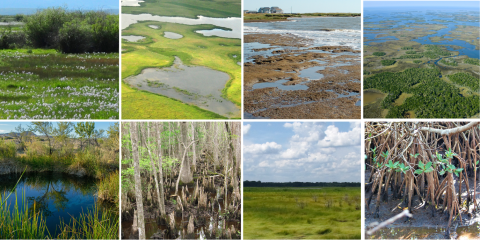Bogged down. Swamped. Muddied waters. Phrases that we use frequently in the working world, but have you ever noticed their not-so-positive reference to wetlands?
Wetlands – areas where water covers the soil – have long had a bad reputation. Presumed to be only a source of flooding and mosquitoes, wetlands have been drained, filled, or otherwise cleared for agriculture or settlement for centuries.
Wetlands are, in fact, awesome.
Wondrous Wetlands
Covering only 6 percent of the Earth’s surface, wetlands are some of the most productive ecosystems in the world and support 40 percent of the world’s biodiversity. They also provide habitat and breeding grounds for several threatened or endangered species in the United States.
Wetlands themselves are as diverse as the life they support: they can be freshwater environments (ponds, bogs, fens, swamps, and wet prairies), brackish areas along coastal boundaries, and saltwater environments (salt marshes, shoals, and mangroves).
We humans may not call wetlands home, but our health and wellbeing are deeply dependent on the existence of healthy and functioning wetlands.
Far from the useless areas they were once believed to be, wetlands:
- Improve water quality – Often described as the “kidneys” of watersheds, wetlands are able to filter and trap pollutants, excess nutrients, and sediment.
- Protect against flooding and stabilize shorelines – Wetlands act as a buffer that absorb the energy and excess water from waves and storms, reducing flood damage to inland areas. Their vegetation and root systems also help prevent erosion.
- Recharge groundwater supply – If a wetland is connected to groundwater system, it can help provide water when stream flows or lake levels are low. This helps maintain the water supply for drinking water and irrigation, as well as for wildlife and plants.
- Sequester carbon – Wetlands capture carbon dioxide from the atmosphere and store it in soil and plants, helping to mitigate the impacts of climate change climate change
Climate change includes both global warming driven by human-induced emissions of greenhouse gases and the resulting large-scale shifts in weather patterns. Though there have been previous periods of climatic change, since the mid-20th century humans have had an unprecedented impact on Earth's climate system and caused change on a global scale.
Learn more about climate change . Peatlands, for example, only cover only about 3 percent of the earth’s surface but store approximately twice the amount of carbon than the entirety of the world’s forests. - Provide recreation opportunities – Healthy wetlands provide myriad of opportunities to connect with nature, whether through photography, fishing, wildlife watching, boating, hunting, or hiking.
The integrality of healthy wetlands to the health of wildlife, plants, ecosystems, and people is a prime One Health example. One Health is a framework that recognizes that the health of humans, plants, animals, and environments are interconnected and when one element thrives, so do the others. In this case, when wetlands are healthy, we all benefit in spades.
The Convention on Wetlands
Recognizing their importance, countries around the world came together in 1971 to adopt the Convention on Wetlands, an intergovernmental treaty on the conservation and wise use of wetlands. Through the Convention (often referred to as the “Ramsar Convention” after the Iranian city where it was signed), countries can designate Wetlands of International Importance, or “Ramsar Sites.” Recognized and protected for their rarity, uniqueness, or their importance for conserving biological diversity, there are now over 2,500 Ramsar Sites around the world. These include:
- In Gabon, the rivers, waterfalls, rapids, and marshes of Chutes et Rapides sur Ivindo provide habitat for several fish that have adapted to the waters’ heavy currents, as well as three of five endemic waterbirds in Cameroon and Gabon.
- The Mubarak Al-Kabeer Reserve in Kuwait features shallow salt marshes and small lagoons. The world’s largest colony of crab plover, along with several other waterbird species, rely on the reserve for breeding grounds. Several dolphins visit the surrounding waters and the Reserve’s water channels provide nursery grounds for shrimp and sea snakes, including the blue-banded sea snake.
- The Kawainui Marsh, sacred to Hawaiians, is the largest remaining emergent wetland in Hawaii and is the state’s largest ancient freshwater fishpond. Located in what was once the center of a volcanic crater, the marsh is habitat for four endemic and endangered waterbirds, including the laysan duck and Hawaiian goose (or nene). The marsh also has archaeological and cultural significance, housing ancient walled taro water gardens (lo’i) where fish were once cultivated.
The U.S. Fish and Wildlife Service's (USFWS) International Affairs program is responsible for designating Ramsar Sites within the United States. We work with federal, state, tribal, and local partners to identify and nominate sites for Ramsar designation. Once a site is designated, we collaborate across the USFWS and with relevant stakeholders to conserve the wetland’s important ecological character. USFWS staff will then research and monitor Ramsar sites to ensure conservation measures are effective. We also do educational outreach to help the public, landowners, and decision-makers better understand the significance of Ramsar sites and wetland ecosystems for environmental, animal, and human health and wellbeing.
To date, there are 41 Ramsar sites in the United States, totaling 4.6 million acres of protected wetland ecosystems. You can explore these sites with our interactive StoryMap .
While our attitudes and understanding of swamps, bogs, and muddied waters has largely improved, much work remains to restore and protect the world’s remaining wetlands. International efforts safeguarding wetlands, like the Convention on Wetlands, are hopeful signs that the world will remain swamped and bogged down (in a good way!) for centuries to come.






